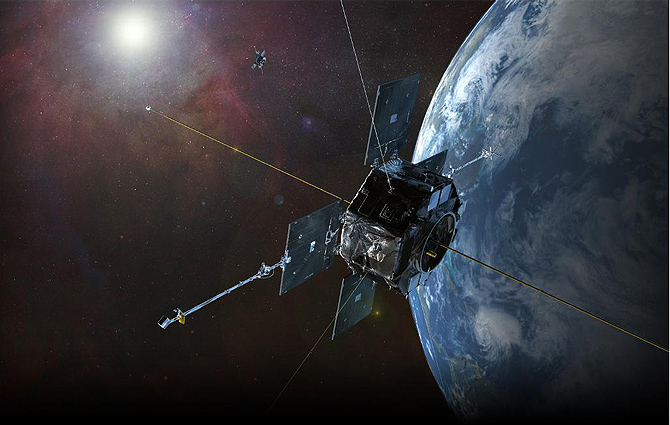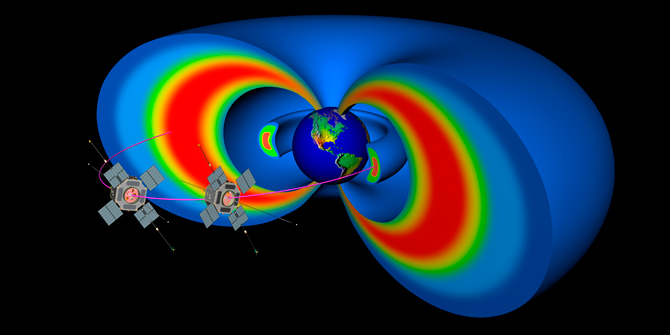

| Visitors Now: | |
| Total Visits: | |
| Total Stories: |

| Story Views | |
| Now: | |
| Last Hour: | |
| Last 24 Hours: | |
| Total: | |
A New Radiation Belt Around Earth Discovered
read more at Anne’s Astronomy News http://annesastronomynews.com/
NASA’s Van Allen Probes mission has discovered a previously unknown third radiation belt around Earth, revealing the existence of unexpected structures and processes within these hazardous regions of space.

A graphic depicting the twin Van Allen Probes in orbit within Earth’s magnetic field. Image Credit: JHU/APL
Previous observations of Earth’s Van Allen Radiation Belts have long documented two distinct regions of trapped radiation surrounding our planet. Particle detection instruments aboard the twin Van Allen Probes, launched Aug. 30, quickly revealed to scientists the existence of this new, transient, third radiation belt.
The belts, named for their discoverer, James Van Allen, are critical regions for modern society, which is dependent on many space-based technologies. The Van Allen belts are affected by solar storms and space weather and can swell dramatically. When this occurs, they can pose dangers to communications and GPS satellites, as well as humans in space.

A cutaway model of the radiation belts with the 2 RBSP satellites flying through them. The radiation belts are two donut-shaped regions encircling Earth, where high-energy particles, mostly electrons and ions, are trapped by Earth’s magnetic field. This radiation is a kind of “weather” in space, analogous to weather on Earth, and can affect the performance and reliability of our technologies, and pose a threat to astronauts and spacecraft. The inner belt extends from about 1,000 to 8,000 miles above Earth’s equator. The outer belt extends from about 12,000 to 25,000 miles. This graphic also shows other satellites near the region of trapped radiation. Image Credit: NASA
“The fantastic new capabilities and advances in technology in the Van Allen Probes have allowed scientists to see in unprecedented detail how the radiation belts are populated with charged particles and will provide insight on what causes them to change, and how these processes affect the upper reaches of Earth’s atmosphere,” said John Grunsfeld, NASA’s associate administrator for science in Washington.
This discovery shows the dynamic and variable nature of the radiation belts and improves our understanding of how they respond to solar activity. The findings are the result of data gathered by the first dual-spacecraft mission to fly through our planet’s radiation belts.

Two giant swaths of radiation, known as the Van Allen Radiation Belts, surrounding Earth were discovered in 1958. In 2012, observations from the Van Allen Probes showed that a third belt can sometimes appear. The radiation is shown here in yellow, with green representing the spaces between the belts. Image Credit: NASA/Van Allen Probes/Goddard Space Flight Center
The new high-resolution observations by the Relativistic Electron Proton Telescope (REPT) instrument, part of the Energetic Particle, Composition, and Thermal Plasma Suite (ECT) aboard the Van Allen Probes, revealed there can be three distinct, long-lasting belt structures with the emergence of a second empty slot region, or space, in between.
“This is the first time we have had such high-resolution instruments look at time, space and energy together in the outer belt,” said Daniel Baker, lead author of the study and REPT instrument lead at the Laboratory for Atmospheric and Space Physics (LASP) at the University of Colorado in Boulder. “Previous observations of the outer radiation belt only resolved it as a single blurry element. When we turned REPT on just two days after launch, a powerful electron acceleration event was already in progress, and we clearly saw the new belt and new slot between it and the outer belt.”

On Aug. 31, 2012, a giant prominence on the Sun erupted, sending out particles and a shock wave that traveled near Earth. This event may have been one of the causes of a third radiation belt that appeared around Earth a few days later, a phenomenon that was observed for the very first time by the newly-launched Van Allen Probes. This image of the prominence before it erupted was captured by NASA’s Solar Dynamics Observatory (SDO). Image Credit: NASA/SDO/AIA/Goddard Space Flight Center
Scientists observed the third belt for four weeks before a powerful interplanetary shock wave from the Sun annihilated it. Observations were made by scientists from institutions including LASP; NASA’s Goddard Space Flight Center in Greenbelt, Md.; Los Alamos National Laboratory in Los Alamos, N.M.; and the Institute for the Study of Earth, Oceans, and Space at the University of New Hampshire in Durham.
Each Van Allen Probe carries an identical set of five instrument suites that allow scientists to gather data on the belts in unprecedented detail. The data are important for the study of the effect of space weather on Earth, as well as fundamental physical processes observed around other objects, such as planets in our solar system and distant nebulae.
Since their discovery over 50 years ago, the Earth’s Van Allen Radiation Belts have been considered to consist of two distinct zones of trapped, highly energetic charged particles. Observations from NASA’s Van Allen Probes reveal an isolated third ring in the outer radiation belt. Video Credit: NASA/Goddard Space Flight Center
“Even 55 years after their discovery, the Earth’s radiation belts still are capable of surprising us and still have mysteries to discover and explain,” said Nicky Fox, Van Allen Probes deputy project scientist at the Johns Hopkins University Applied Physics Laboratory in Laurel, Md. “We thought we knew the radiation belts, but we don’t. The advances in technology and detection made by NASA in this mission already have had an almost immediate impact on basic science.”
The Van Allen Probes are the second mission in NASA’s Living With a Star Program to explore aspects of the connected sun-Earth system that directly affect life and society. Goddard manages the program. The Applied Physics Laboratory built the spacecraft and manages the mission for NASA.
The paper “A Long-Lived Relativistic Electron Storage Ring Embedded in Earth’s Outer Van Allen Belt,” was published Thursday 28 February 2013 in the journal Science by D.N. Baker.
Source: The National Aeronautics and Space Administration (NASA)
n/a
2013-03-02 09:19:33
Source: http://annesastronomynews.com/a-new-radiation-belt-around-earth-discovered/
Source:


